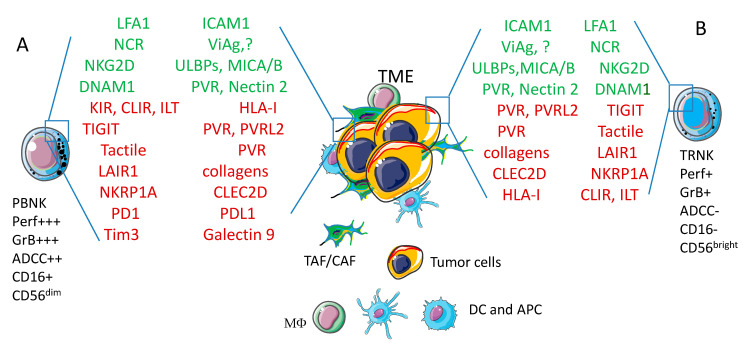Figure 2.
Phenotype of peripheral blood (PBNK) and tissue resident (TRNK) NK cells. The large majority of PBNK (A) express CD16 and through this receptor for the Fc portion of immunoglobulins can activate the ADCC that induces the release of perforin and granzymes to kill target cells. A minority of PBNK does not express CD16, but displays high surface amounts of CD56 (CD56bright) antigen; these PBNK cells are similar to tissue TRNK (B). NK cells express a plethora of activating (green) or inhibiting (red) receptors that can interact with the corresponding ligands expressed on tumor cells within the tumor microenvironment (TME). Other cells of the TME, such as tumor/cancer associated fibroblasts (TAF/CAF), dendritic cells (DC) or antigen presenting cells (APC) and macrophages (MΦ) are also depicted. The engagement of activating receptors triggers cytolysis of tumor cells and/or the release of cytokines while the interaction of inhibiting receptors with corresponding ligands impair NK cell-mediated activities. The final net effect (triggering or inhibition) is determined by the balance of these positive and negative signals. The receptors and ligands mentioned in the figure are analyzed in detail in the text. Acronyms. LFA1: lymphocyte function antigen 1; ICAM1: intercellular cell adhesion molecule 1; NCR: Natural Cytotoxicity Receptor; ViAg: viral antigen; ?: not yet identified ligands; NKG2D: NK related group 2D; ULBPs: UL binding proteins; MICA/B: MHC-related molecule A/B; DNAM1: DNAX adhesion molecule 1; PVR: polio virus receptor; KIR: killer immunoglobulin receptor; CLIR: C-lectin inhibitory receptor; ILT: Immune lymphocyte transcript; HLA-I: human histocompatibility antigen; TIGIT: T cell immunoreceptor with Ig and ITIM domains; PVRL2: poliovirus receptor related 2; LAIR1: Leukocyte associated inhibitory receptor 1; NKRP1A: NK related protein 1A; CLEC2D: C-type lectin domain family 2 member D; PD1: programmed death receptor 1; PDL1: programmed death receptor ligand 1; Tim3:T-cell immunoglobulin and mucin-domain containing−3; Per: perforin; GrB: granzyme B; ADCC: antibody dependent cellular cytotoxicity.

